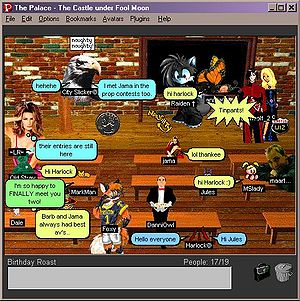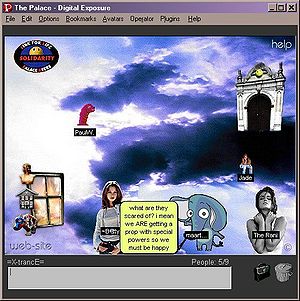The Palace
 From EduTechWiki - Reading time: 4 min
From EduTechWiki - Reading time: 4 min
Introduction[edit | edit source]
The Palace is a 2D interactive environment or with more words, a rich 2D virtual multi-user chat environment. It was popular in the late nineties and it still has its followers.
“The Palace is a software program used to access graphical chat room servers, called palaces, in which users may interact with one another using graphical avatars overlaid on a graphical backdrop. The software concept was originally created by Jim Bumgardner, an employee of Time Warner Interactive, in 1994, and was first opened to the public in November 1995.” (Wikipedia, retrieved 19:43, 16 September 2010 (CEST))
Main features:
- A server is organised in rooms which are connected through doors. Each room is represented by a large Bitmap
- Users are represented by partially transparent 2D avatars, by default smilies
- Chat appears as chat bubbles above the avatars like in comic books
A palace server can be configured to include various extensions. There exist (free) versions that could (and still can) be run on consumer PCs and this may be the reason why Palace servers are still popular 10 years after the death of the company.
Software[edit | edit source]
Clients[edit | edit source]
Palaceplanet.net provides downloads for the "classical" clients and also has links to the more popular clients which are listed below.
- Clients at Palaceplanet.net You may need a classic client to administer the server. (still works under Windows 7)
- OpenPalace (Flash client). See also the OpenPalace Wiki
- PalaceChat (Newer Windows client that improves color and size of the original classic client)
- Phalanx (Windows client)
- The Palace Legacy Project
- Linpal (Linux, inactive since 2004)
As you can see in the two screen shots below, a room is visually defined by Bitmap (more precisely a 528 x 530 px Gif file. with a reduced color scheme. A sort of 3D effect can be simple obtained by choose a picture that has some perspective.
 |
 |
Servers[edit | edit source]
- Palace Server Software (Win/Linux/Unix/Mac). If we understood right, this web site hosts the original servers. Not tested, no idea how safe this software is. As of sept. 2010, still worked under Ubuntu 10.04 LTS - Daniel K. Schneider 19:43, 16 September 2010 (CEST).
- Linux Palace Downloads “Host your own Palace on Linux. The most secure Palace server solution. You can use all the best Palace plugins to make your server even more secure. Use this Registration code for all your servers: 6DV3K-PVY6F-RF2VT-QFG8S it has a couple of benefits: 2550 users max, secure server and Guests will be full members.” retrieved 19:43, 16 September 2010 (CEST).
- The Palace Legacy Project also provides a copy of the same Unix server (but it has a different file name).
Manuals:
Extra client and server tools[edit | edit source]
- Palaceplugins.com Plugins for the linux palace server.
Similar technology[edit | edit source]
- The manor (Mad Wolf Software)
Installation[edit | edit source]
Linux server installation[edit | edit source]
The shortest information about server management can be found in the RELNOTES file that is distributed with the server.
Unpack the tar.gz archive, then type ./install and answer questions (easy to understand)
Chown the whole directory to a non-root user.
Immediate post-installation[edit | edit source]
You may do all system administration through a client. Alternatively it's also an option to edit palace/psdata/pserver.prefs where the server writes out the options. Create a backup file first.
- To connect as owner first time, type:
~susr owner
- To connect as owner next times, type:
~susr operatorpassword
- To change both owner's and operator's password, type:
'ownerpass newpassword 'operatorpass newpassword
- To shut down, type:
shutdown
or alternatively, in a server terminal, type:
bin/.stop-palace
The web server[edit | edit source]
Can be replaced by your normal server on the same or a different machine. Then, if you put the media in /palace/media on a regular httpd server on your.server.org, type e.g.:
'fileserver "http://your.server.org/palace/media/"
You likely may have to do this, the included Apache server may be too old for your system. "localhost" also should work
Palace templates[edit | edit source]
A Palace and its "rooms" are defined in file palace/psdata/xxx.pat. By default, you already have a pserver.pat
The pat file includes room definitions (you can look at the file) that are fairly simple: and id, a name, a picture, a list of "props" and definition for doors.
The easiest way to change the look of your Palace is to download a template from Palaceplanet.net and then have your Palace use this new one. As of september 2010, there was a choice of 9 templates.
To switch templates, type e.g.
'roomsfile "psdata/Beach.pat"
or
'roomsfile "psdata/beachresort.pat"
If you get it wrong, you'll have to hand edit pserver.prefs
Links[edit | edit source]
- About the Palace
- The Palace (computer program) (Wikipedia)
- A Little Palace History. By Jim Bumgardner (main inventor of palace). In particular, a 2002 Interview with Jim Bumgardner is absolutely worth reading.
- On Being a God (Virtual Worlds) interview of Jim Bumgardner by Dr. John Suler, 1996
- Palace finds new realms, CNET, 1996.
- The Palace Inc (The Palace Wiki Project)
- Yahoo! Internet Life magazine article, summary and scan of a 1999 article.
- Examples
- Minds Palace (dead, but the HTML pages are still around)
- Support groups and sites
- Palace Server and Client Support group (Yahoo group)
- ThePalace.com Old official website bought by Palace fans. Includes a Palace directory and links.
- Palace Planet. The community portal. Includes forums and downloads (or links to downloads)
- The Palace Wiki Project (information about history and current stuff)
 KSF
KSF